
PART II
PERSPECTIVE AS PRACTISED BY OTHER NATIONS AND AT OTHER TIMES
CHAPTER XIX
PERSPECTIVE IN GREEK AND ROMAN AND OTHER PAINTINGS
If we attempt to resurrect those early days when perspective was first recognised we should have to probe into the archives of antiquity. For it seems that Vitruvius (who wrote his treatise on architecture about 46 B.c.) casually mentions that perspective was well understood at a very early date ! He tells us that a certain Agatharchus, a painter in Athens, " was the first who contrived scenery upon which subject he left a treatise." Agatharchus was in fact employed by Eschylus (born 525 B.c.) to paint scenes for his plays that he produced late in life ; moreover his scenery laid out by the principles of perspective was, at the time, a distinct novelty.
The treatise that Agatharchus wrote, or perhaps it was the scenery itself, excited Anaxagoras to take up the pen in explanation of how " in drawing the lines ought to be made to correspond, according to a natural proportion, to the figure which would be traced out on an imaginary intervening plane by a pencil of rays proceeding from the eye, as a fixed point of sight, to the several points of the object viewed." [1]
Fuseli, speaking of the great painter of the same period as Agatharchus, says, " The first great name of that epoch .. . is that of Polygnotus of Thasos who painted the pcecile at Athens, and the public hall at Delphi. Of these works Pausanias gives a minute and circumstantial detail, by which we are led to surmise that what is now called composition was totally wanting in them as a whole ; it appears as plain that they had no perspective, the series of figures on the second or middle ground being described as placed above those on the foreground, as the figures in the distance above the whole ; the honest method, too, which the painter chose of annexing to many of his figures their names in writing, savours much of the infancy of painting. We should, however, be cautious to impute solely to ignorance or imbecility what might rest on the firm base of permanent principle. . . . If we consider the variety of powers that distinguished many of the parts, we must incline to ascribe the primitive arrangement of the whole rather to the artist's choice and lofty simplicity than want of comprehension ; Nature had endowed him with that rectitude of taste which in the individual discovers the stamen of the genus, hence his style of design was essential with glimpses of grandeur and ideal beauty."
1. "Dictionary of Greek and Roman Mythology.."
Perspective with its realism would have been antagonistic to the aims of the painters of that period, a reason that also holds good for its exclusion in the art of the Egyptians.
A century later we find the school of Pamphilus—which was founded by Eupomus—with very different aims and execution. The decorative work of Polygnotus, big in conception, had meanwhile been changed by Apollodorus, Parrhasius, and Zeuxis, to a more imitative style, by the addition of light and shade, gradation of multiplied tints, and elegance of proportion.
Pamphilus, with a knowledge of geometry and an extreme love of accuracy, taught that science and art must go hand in hand.
Apelles, Melanthus, Protogenes, and Euphranor all came under his influence. Numerous stories are told of the accuracy of eye and precision of hand practised by them.
Those painters whose works were acknowledged, acclaimed, and extolled as masterpieces lived when Greek architecture and sculpture flourished at its best. Among their critics and commentators were cultivated men whose writings still afford examples of consummate art. In their day drawing was practised as an indispensable part of the education of the upper classes. Their schools of painting had definite aims and traditions, their national characteristic was the close following of Nature's forms.
With such a training it is impossible to believe that perspective could have been overlooked, misunderstood, or despised ; it was essential to their aims of realism ; it would follow naturally in their zeal for, and practice in, exactness ; and would have been acquired as an adjunct of art in their self-imposed education.
Sir Joshua Reynolds has said, speaking of their pictures, " I have no doubt that we should find their figures correctly drawn as the Laocoon, and probably coloured like a Titian." Let us add that Canaletto would not have rivalled their perspective and we may not be missing the mark, though it is but a reasonable conjecture.
Perspective in Roman paintings.—I cannot understand why the credit of discovering perspective should often be given to the early Italians, while existing evidence of its recognition by the Romans can be seen on the walls of Pompeii (Illus. LXIX). It is evident that in simple parallel perspective (the Italians till quite a late period did not understand angular perspective) they were very well versed though without the accuracy we now expect.
The perspective of these wall decorations is of the standard shown in the rest of the work. If this was the work of slaves and " some bow-backed artificer or other, who can paint many faces in a short time," as Juvenal calls them, the work of the better artists must have been very accomplished and their perspective, as far as it essayed to go, irreproachable.
The foreshortening of the horses and men in the battle of Alexander, though a Greek work, is sufficient evidence of a sureness in workmanship, and observation of Nature, totally lacking in the beautiful early attempts of the Italians.
THE EARLY ITALIANS, A.D. 1200-1400
In the thirteenth century, by the genius of the Florentines, Cimabue (1240-1308) and his pupil Giotto, and the Sienese Duccio, painting was given fresh life, and the era began in which Nature and beauty had its resurrection.
The new aim of realism grew in strength and seems to have been readily recognised by the nickname, " the ape of Nature," given to Stefano (b. 1301).
The work of Fra Angelico (1387-1455) is so reverent and full of a child-like simplicity that it would seem like sacrilege to subject his visions to the cold light of reasoning. Without doing so, we can give instances where his ability lagged behind his conception. As in his " Martyrdom of St. Mark," in which he signally failed to make the Saint lie flat on the ground ; nor did he realise that the parallel faces of buildings would recede to one and the same vanishing point. His constant observance of the spacing in receding rows of columns, no less than his study of a carpet in the " Madonna of San Marco," make it a matter of wonder that he should have blundered so completely in the placing of the figure of Christ in the " First Eucharist " (San Marco, Florence). The Saviour is represented placing the wafer in St. John's mouth, though his hand is at least seven feet away from the Apostle's mouth.
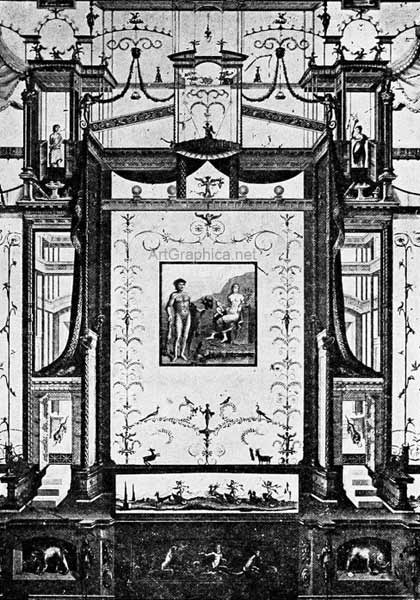
Illus. LXIX. (Photo. Alinari.)
Painting on the walls of Pompeii. Parts of it are so illusive as to appear
as an actual framework.
Paolo Uccello (1397-1475), a contemporary of Angelico, appears to have been the first scientific exponent of perspective.
How admirably he put his deductions into practice is seen in his battle picture, now in our National Gallery (" Rout of San Romano," Illus. LXX) The foreshortening of the fallen figure, the lances, the spacing of the ground, and the beautiful drawing of armour, show the strides he had made in his study.
Vasari tells us how " Paolo Uccello employed himself perpetually, and without any intermission whatever, in the consideration of the most difficult questions connected with art, insomuch that he brought the method of preparing the plans and elevations of buildings, by the study of perspective, to perfection. From the ground plan to the cornices, and summit of the roof, he reduced all to strict rules, by the convergence of intersecting lines, which he diminished towards the centre, after having fixed the point of view higher or lower, as seemed good to him : he laboured, in short, so earnestly in these difficult matters that he found means, and fixed rules, for making his figures really to seem standing on the plane whereon they were placed, not only showing how, in order manifestly to draw back or retire, they must gradually be diminished, but also giving the precise manner and degree required for this, which had previously been done by chance, or effected at the discretion of the artist, as he best could. To pore over all these matters, Paolo would remain alone, seeing scarcely anyone, and remaining almost like a hermit for weeks and months in his house, without suffering himself to be approached."
The early Florentines produced inimitable works which fortunately for us were visions of their subject rather than the reality they strove for. Bit by bit the result of observation crept into their work. One after another added a law of nature as he recognised it, or as he acquired the power of recording it. Among them were men who called science to help, and talked and wrote of their new perspective. There can never be another Cimabue, Angelico, Lippi, or Botticelli. We can delight in their sweet conceptions wholeheartedly without the taint of analysis or criticism.
From Masaccio to Leonardo da Vinci.—With few exceptions up to the time of Masaccio (1401-1443) figures of no individual likeness sat irresponsibly under little arcades, or tiptoed with dolls' houses set about them in a charming land of their own. They had no connection with the world of pleasure and pain, and they took the thoughts of those who watched them far away from it, as was their mission.
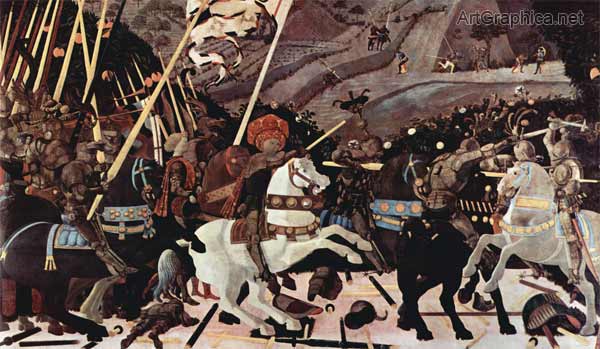
Illus. LXX. Paolo Uccello. (Photo. Mansel).
ROUT OF SAN ROMANO.
" He shut himself up, devoting himself wholly to the study of perspective, which kept him in poverty and depression to the day of his death." — Vasart.
Masaccio brought real figures into his deisgns. They were modelled in relief ; capable of casting shadows ; they formed groups and walked firmly heel down on level ground.
The Jaws discovered by Uccello were recognised by him in Nature and copied with surprising mastery.
His portrait of an old man (now in the Uffizi Gallery) was taken at close quarters, as we see by the depth of the foreshortened surface.
The same study if painted far away from the sitter would have lost much of its realism. In later days the Dutch school made great use of this notion of the spectator being among the objects painted, or let us say at arm's length from them. And it is then that acquaintance with perspective becomes invaluable, for the distortion of near receding surfaces may easily become disagreeable while the introduction of an object outside the field of vision may make the picture incongruous.
Vasari wrote his biography in fifteen hundred and something, and we gather from his descriptions of pictures that the perspective of rather simple forms still in his day presented difficulties, so that the men who overcame them were given praise quite disproportionate to that merited by their artistic conception. Thus, speaking of a picture by Piero, " Above these figures is a most beautiful Annunciation, with an angel which seems in truth to have descended from Heaven ; and what is more, a range of columns diminishing in Perspective which is indeed beautiful."
It would seem that a range of columns and an angel from Heaven were artistically on a footing !
These were early days for tackling the intricacies of a vaulted roof, but Andrea dal Castagno (1410-1457) introduced into a fresco a loggia with cross-vaulting and ribs diminishing in perspective which gained the approval of his contemporaries.
We find constant reference made to drawing of objects, such as the octangular table that Cosimo Rosselli (1439-1506) painted, and the accuracy of eye displayed by Domenico Ghiflandaio (14491494), who could draw an amphitheatre or an obelisk correctly without measurement.
The rise of perspective (let us say the revival of it) belongs particularly to these early painters of Florence, but we must not forget Jan Van Eyck of the Netherlands (1385-1441) with his wonderful portrait interior (No. 186, National Gallery). He stood close in front of the man and his wife with their little dog and painted them and the room just as he saw them at close quarters, and made his receding surfaces as accurate as they need be.
Nor will it do to omit Andrea Mantegna (of Padua, 1431-1506) who carried the foreshortening of figures a step further.
There is a picture in the National Gallery by Beccafumi (Sienese, 1486-1551). It is characteristic of the uncertain use made of perspective at that time. He carries his receding lines with care to a vanishing point, but when introducing some of the buildings of Rome incongruously draws them as they would be seen from another level.
Filippino Lippi (1457-1504), with his power of composition, seems generally to have overcome the difficulties of foreshortening. His architecture, in the " Triumph of St. Thomas Aquinas," is drawn just as surely as his " Music " (in S. Maria Novella, Florence) with its very low horizon.
The early painters aimed at making their figures look real. Their study of architectural perspective led them in this respect into a theatrical extravagance in order to obtain the illusion of nature. This they did by continuing in their painting an imitation of the adjacent architecture, so that one can hardly tell where one leaves of and the other begins. Giovanni Bellini used perspective in this way on his altar-piece at San Zaccaria, in Venice. Even Leonardo da Vinci and Michelangelo did not despise the device.
From Leonardo to Veronese. - Leonardo da Vinci (1452-1519), with his enlightened genius for art, mathematics, science, and mechanics, gave finish to the new ideals which Masaccio began.
He ushered in the great period when genius, no longer the monopoly of one school, brought painting to perfection.
Perspective was no longer a mystery to be studied and used tentatively. It had become an essential tool of the workman. The difficulty was no longer in copying Nature, but in choosing the best way in which she should be represented.
Giorgione and Titian discovered the beauty of space and unity between the land and sky, trees were given their fullness and land its level plains. Diirer, engrossed in studying line, learnt all he could of the laws of perspective, and even went to the trouble of tracing objects on an upright glass in order to perfect the accuracy of his eye, and has left us some of his principles in his book on Geometry.
In the Christ Church Collection at Oxford there is a sketch by Raphael of figures (Illus. LXXI) standing in groups, the floor being divided into 'a number of receding squares. Beneath this drawing is the plan of the floor correspondingly divided into squares with the position of the figures on them. It is of interest to note that he should have taken the pains first to draw a plan of the surface on which he was to place his figures. This method, a common one among latter-day painters, has already been described. Vasari says, " Among other artists, Raphael formed a close intimacy with Fra Bartolommeo di San Marco, during his abode in Florence, the manner of that master pleasing him greatly, wherefore he took no small pains to imitate his colouring, teaching that good father on his part the rules of perspective."
A curious use was made of the knowledge of perspective in Venice during this period. In the words of Lanzi, " It became an attribute of the art to feign colonnades,' galleries, and rich cornices, for those halls in which real architecture would not admit of them. In this, Cristoforo and Stefano Rosa more particularly distinguished themselves. They were from Brescia, very intimate with Titian, and merited the honour of being employed by him, in his architectural ornaments for several of his subjects " : those painted illusions were referred to as " Perspective Pieces," and appear to have been very popular.
How fond Veronese was of figures placed high up with a low horizon. We see how dignity is added to his picture " Respect " by his choice in placing the horizon low down. In his " Family of Darius at the feet of Alexander " our eye is on a line with the feet of the foreground figures. In the tall upright, " The Vision of St. Helena," the horizon is just about the bottom of the picture.
From Veronese to Rembrandt. — It was just after the period of Veronese that painting came to the front in other countries besides Italy, Germany, and the Netherlands.
National art had its rise in France, England, and Spain ; while numerous Flemish and Dutch schools were established.
The giants of those days gave a new purpose to perspective.
Claude carried it into the sky and the sea, Rembrandt into the mystery of night and artificial lighting. Frans Hals discovered perspective in the paint itself, by his brush-strokes. With its aid Rubens built up the staging for his scenes.
The subject-painters Ostade, Terborch, and others obtained by it a just proportion between figures and surroundings. The painters of still-life must have had perspective at their finger-tips when drawing the ellipses of their shining copper pans and placing the high lights on their transparent glass.
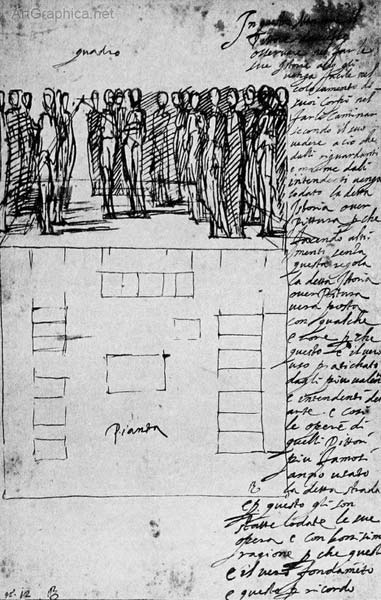
Illus. LXII. Clarendon Press, Oxford.
A Drawing by Raphael at Christ Church, Oxford.
Ruskin covered pages with invective on Claude's art and sneered, without cause as far as I can see, at his perspective. Here is a sample : " The eye of this artist, with all his study, had not acquired the power of taking cognizance of the apparent form even of a simple parallelepiped." Perhaps Ruskin was right, but then I don't know what a parallelopiped is. Anyhow, it is a small matter in a picture (" Queen of Sheba embarking," now in the National Gallery) that shows Claude as a master of perspective in things that really matter.
With knowledge and more tolerance he criticizes another picture in which Claude had painted a band of light—the reflection of the sun—crossing the sea obliquely instead of vertically. " Taking his impression instinctively from Nature, Claude usually did what is right and put his reflection vertically under the sun ; probably, however, he had read in some treatise on optics that every point in this reflection was in a vertical plane between the sun and spectator ; or he might have noticed, walking on the shore, that the reflection came straight from the sun to his feet, and intending to indicate the position, of the spectator, drew in his next picture the reflection sloping to this supposed point, the error being excusable enough, and plausible enough, to have been lately revived and systematized. . . . Every picture is the representation of a vertical plate of glass, with what might be seen through it drawn on its surface. Let a vertical plate of glass be taken and wherever it be placed, whether the sun be at its side or at its centre, the reflection will always be found in a vertical line under the sun, parallel with the side of the glass." When Ruskin finishes a page of abuse (concerning Claude's foregrounds)[1] with the words, " owing to his total ignorance of the laws of perspective," etc., he was writing piffle, as he sometimes did when not engaged in expressing beautiful and helpful thoughts in beautiful and thoughtful language.
The biographer and artist Baldinucci, who was a contemporary of Claude, tells us something of Claude's methods[2] " He placed his eye where it seemed good, but he was wont to divide the height of his picture into five parts, of which two were inferior to the horizontal ine, or I should say that of the visual rays. Then placing the eye on this line, he took a thread and placing one end at the eye, he rotated it in a circle upon the picture, including in this circle the whole of the said picture. Then he placed his distance upon that spot where the line traversed the circle. He adopted the same method in drawing views from Nature, and the line in question played so an important a part in his works, that with the Flemmings he got the name of " Orrizonte." In other words, Claude usually made the horizon two-fifths of the height of the canvas : selected a good position for P.V.P. on the horizon ; measured the distance from his eye to the P.V.P., and marked off that distance on either side of the P.V.P. to find D.V.P.'s.
1 Pt. II, Se. IV, Chap. IV, "Modern Painters."
2 Quoted from Edward Dillon's "Life of Claude."
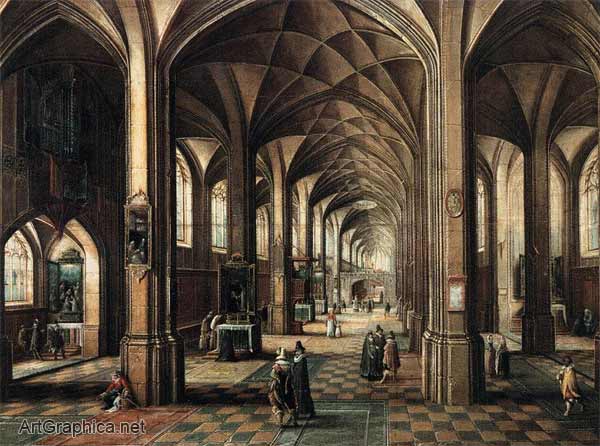
Illus. LXXII Hendrick Steenwyck. (Photo. Mansel.)
INTERIOR OF A CHURCH.
It is interesting to find that in both the pictures, " Temple of Apollo at Delos " (Rome), " Embarkation of St. Ursula " (National Gallery), the horizon is as mentioned, two-fifths up the canvas.
Claude learnt his perspective from Agostino Tassi, who had studied under Paul Bril. We learn of Tassi that he imitated Bril in his landscapes, " and was also distinguished as a painter of architecture and perspective, in which he had considerable employment, till for some offence he was sent to the galleys. During his confinement he amused himself by painting marine subjects."[1]
Caravaggio (1569-1609), in his picture " Christ carried to the Tomb," placed his horizon on the ground, consequently no space of it is visible between the feet of the standing figures, the feet coming all on a line.
Rubens often used a low horizon. In his half-length portrait of the Archduchess Isabella (Brussels Museum) the horizon is below the picture, for we can see the underside of the balcony rail, which, quite low down, is used to hide the excessive corpulence of Isabella. The horizon in " The Emperor Theodosius repulsed by St. Ambrose " is on a level with their ankles.
Early in the book we gave instances of a low horizon used by Ribera and Velasquez, and reproduced the latter's " Dead Warrior " (Illus. XIV, Chap. IV) when speaking of foreshortened figures.
Rembrandt made great use of the massive shapes of shadows by artificial light, and their habits of searching out the forms of surfaces they fall on. The radiating bands of light and shadows, from a lantern could, in his hands, be one of the central points of a great composi-tion. Understanding the simple laws that govern such light he could use it at will in his mastery over what is mysterious and grand.
The " Anatomy Lecture " is one of many among the great works of that period that reveal the acute sense of the artist's taste in the matter of choosing a not too large or small angle of vision, and in avoiding surfaces that would disclose what the angle of vision actually was. Their pictures in consequence have that appearance we envy, of looking well, both at a distance and near by. The "Anatomy Lecture " looks correct when seen far off by reason of the heads being so similar in size. The men must have been standing with distance between them. If, therefore, Rembrandt had painted close up to the group he would have made the nearest heads much larger than those behind, and the picture seen from a distance would have looked wrong. His " Syndics of the Cloth Hall " is another instance of a low horizon giving dignity to the subject.
1 Pilkington's " Dictionary of Painters," 1829.
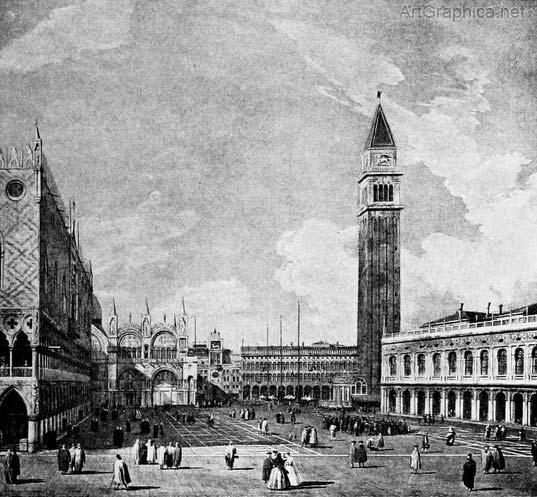
Illus. LXXIII. Canaletto (photo mansel).
ST. MARK'S
One also comes across examples of a mistaken use of a very low horizon. Nicholas Berchem, for instance, in his etchings made capital out of the perspective of hilly ground, by placing his spirited figures and animals partly hidden by rising land, or to give life to odd corners. But when, as I remember, he drew a sheep standing on a vast plain with the horizon just above its feet, he must have sketched lying on his stomach. It is not this I object to, but to the comic dignity of that immense sheep. We see sheep on a hill-top outlined against the sky, but that is another story.
The foreshortening of a floor immediately reveals the distance the painter was from the scene. If he was close to it, and his angle a wide one, his picture might look distorted unless seen from a few feet away. If he were a long way from the scene his figures -might look too similar in size to be forcible, and his picture would look incorrect unless one saw it only from a distance. We see in the masterpieces of this period instances of figure groups in which the feet are hidden, as by the space they occupy they would immediately explain the distance.
The painters of architecture, Hendrick Steenwyck, his son of same name, and Pieter Neefs, display an amazing ability in rendering by perspective lines alone the idea of space. One could pick out a little mistake here and there in the direction of their lines and the course of their curves if one were not fully occupied in wondering at their patient skill as they copied each column and arch. I think they must have set out the floor by perspective rule, to enable them to fit the objects on it, each in its place (Illus. LXXII).
Emanuel de Witte did not rely on perspective so entirely, but introduced spaces of light and shade.
The elaborate painting in detail in the " Interior of an Art Gallery," by Hans Jordaens (Illus. XIII), in the National Gallery, is amazing.
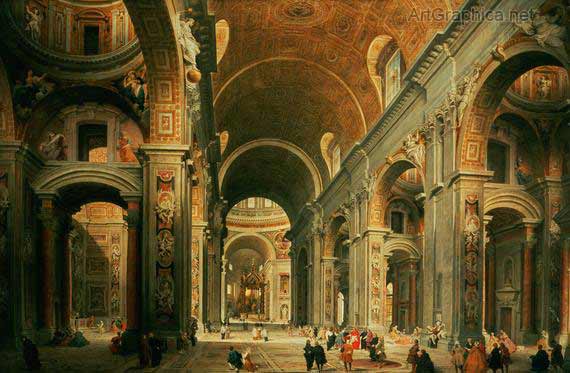
Illus. LXXIV. Panini, 1695-1768, (Photo. Mansel.)
INTERIOR OF ST. PIERRE, ROME.
Only the simplest of perspective rules are required for such a subject, but for exactness of hand it borders the limit of human performance.
There is no need to call attention individually to the uniform correctness in the perspective of the Dutch Genre painters : De Hooch's interiors and courtyards can be taken to illustrate the laws of parallel perspective, as might Hobbema's delightful " Avenue, Middleharnis," in the National Gallery.
One notices the low horizon sometimes employed by Paul Potter, and the dignity it gave to his cattle seen against the sky.
The still-life painters might employ a high horizon with success, and a wide angle of vision, since a bowl of fruit or a bouquet can be seen and drawn when close up to you. The almost miraculous painting in some of the still-life must be closely examined or the daintiest of human work be wasted. All this detail would be lost, all the elaboration a defect, and the angles appear horribly distorted if the picture can only be seen from a long distance. For this reason I think such subjects or any other with a wide angle of vision should preferably be on a very small scale, suitable for little crowded rooms where they can be enjoyed nose to frame.
The picture that towers grandly in the gallery is the one of big blank surfaces of sumptuous colour and atmospheric tone ; the low horizon, and the piled-up composition of a Venetian master.
Canaletto (1697-1678) (Illus. LXXIII) and his nephew Bellotto, with their pupils Marieschi and Vicentini, formed a small school that relied implicitly on perspective for their composition. They chose a good architectural subject—copied it precisely—and under-standing the effect of receding lines, realised the impression of immense space and flatness of ground on their canvas. You see what I mean by looking at Canaletto's " Piazzetta," in the National Gallery. It interests you first by the deception of space, secondly by his colour, and thirdly by the purity of the air that enables him to record the intricacies of architectural detail.
Francesco Guardi (1712-1793), more exuberant and without the exactness or restraint of Canaletto, his master, shows us that rich detail of multiplied ornament, can, by free handling, suggest the sumptuousness of an interior. He showed considerable skill in crowding the floor with figures that were, by comparison with the height of the walls, quite tiny, and yet not insignificant.
|